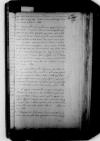Letter #5793
Alfonso de VALDÉS to Ioannes DANTISCUSs.l., [1526-09-18 — 1526-12-10 or 1527-01-26 — 1527-03-30 or 1527-10-18 — 1528-12-17 or 1529-04-20 — 1529-07-27 or 1529-08-12 — 1529-10-18 or 1529-11-05 — 1530-04-18]
English register:
Valdés asks Dantiscus to show understanding. He is short of time for meetings because he has to be with the chancellor [Mercurino Gattinara] every day. The best time for this is dinnertime because he dislikes going out in the evenings. That’s why he cannot have dinner with Dantiscus today, but if he has time he will come tomorrow. The emperor will probably sign the promised letters to the king [Sigismund I] and queen [Bona] and the passport (litterae commeatus) tomorrow. Valdés made sure that copies of the letters from the king [Sigismund I] and queen [Bona] to the emperor were made for Dantiscus. Valdés thinks everyone here owes so much to the virtues and services of Dantiscus that there is no need for him to pay the scribe for the copying work.
Manuscript sources:
Auxiliary sources:
Prints:
| ||||||||||
Text & apparatus & commentaryPlain textText & commentaryText & apparatus
Salutem.
Scias tu quidem, amice, quod meam negligentiam in meliorem partem interpretaris. Nihil certe mihi aut gratius, aut dulcius tua consuetudine esse posset. Cogor tamen semel in die convenire
ms 1 ... gap left by scribe⌈quaesoms 2 quaeso,
ms 1 ... gap left by scribe⌉, me excusa venturum cras ad prandium, si vacabit, nam hodie non licet nec possum. Ceterum omnes litterae tuae, tum ad
ms 1 nundum⌈nondumms 2 nondum,
ms 1 nundum⌉ tamen a
Vale.

 BK 222, No. 54, p. 200
BK 222, No. 54, p. 200